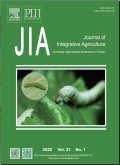首页|期刊导航|农业科学学报(英文)|Autophagy-related protein PlAtg3 participates in vegetative growth,sporangial cleavage,autophagy and pathogenicity of Peronophythora litchii
农业科学学报(英文)2024,Vol.23Issue(11):3788-3800,13.DOI:10.1016/j.jia.2024.01.009
Autophagy-related protein PlAtg3 participates in vegetative growth,sporangial cleavage,autophagy and pathogenicity of Peronophythora litchii
Autophagy-related protein PlAtg3 participates in vegetative growth,sporangial cleavage,autophagy and pathogenicity of Peronophythora litchii
摘要
关键词
PlAtg3/sporangial cleavage/autophagy/pathogenicity/Peronophythora litchiiKey words
PlAtg3/sporangial cleavage/autophagy/pathogenicity/Peronophythora litchii引用本文复制引用
Chengdong Yang,Wanzhen Feng,Qinghe Chen,Manfei Luo,Xue Zhang,Linlin Ye,Ge Yu,Yi Lü,Yi Chen,Taixu Chen,Xuejian Wang..Autophagy-related protein PlAtg3 participates in vegetative growth,sporangial cleavage,autophagy and pathogenicity of Peronophythora litchii[J].农业科学学报(英文),2024,23(11):3788-3800,13.基金项目
This work was supported by the grants from the Hainan Provincial Natural Science Foundation,China(321QN190 and 321CXTD437),the National Natural Science Foundation of China(32202246 and 32160614),the Open Project Program of Fujian Key Laboratory for Monitoring and Integrated Management of Crop Pests,China(MIMCP-202102),and the Scientific Research Foundation of Hainan University,China(KYQD(ZR)-21042 and KYQD(ZR)-20080). (321QN190 and 321CXTD437)

